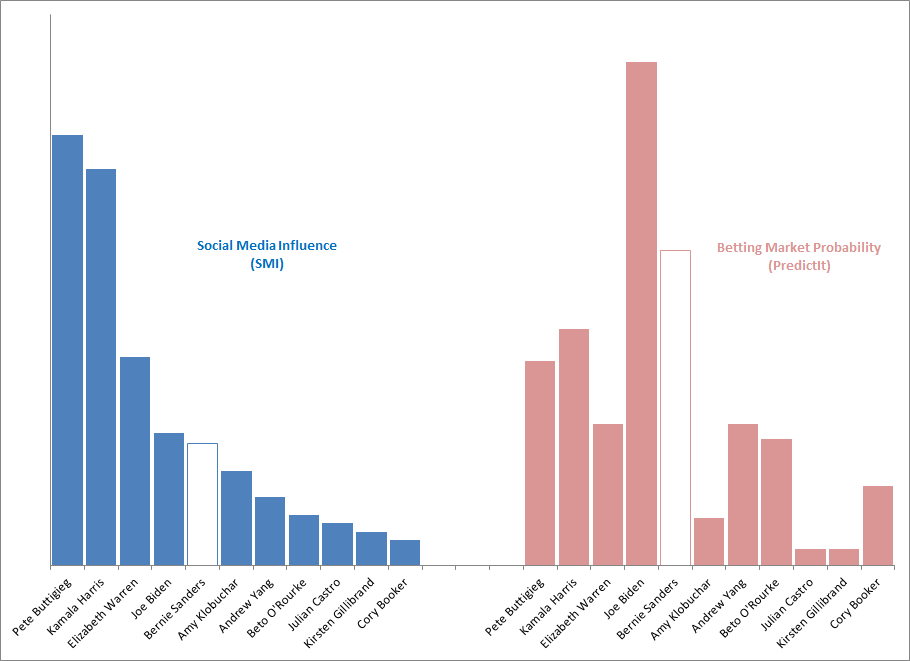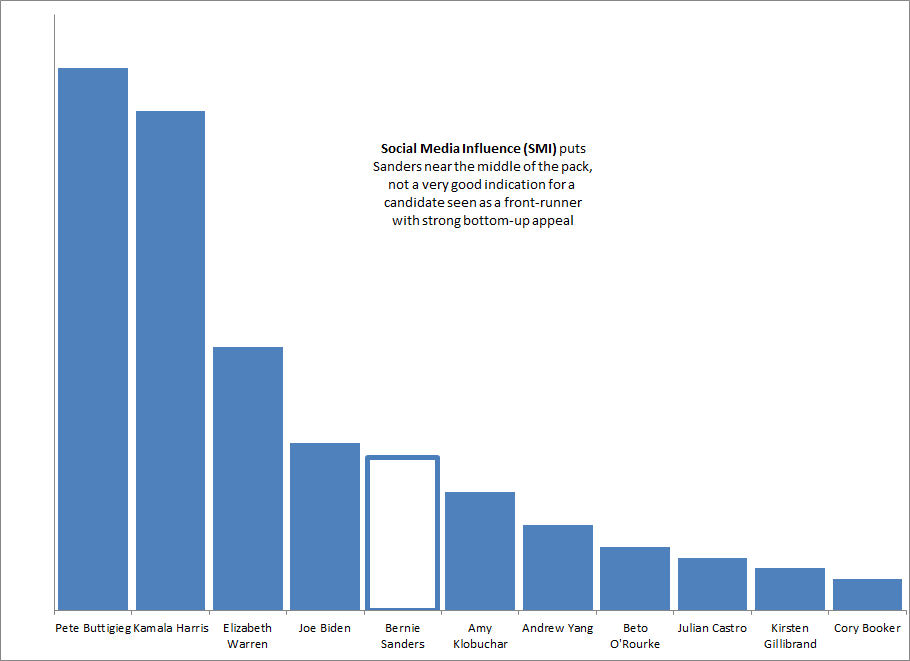Summary
ZettaCap sees Bernie Sanders performing worse in the 2020 election cycle than during 2016.
According to Social Media Influence (SMI), Sanders in 2020 is in a distant 5th place which is a far cry from his close 2nd place during the 2016 cycle. The divergence of his weak SMI with his strong poll and betting market positions is painfully obvious.
We believe Sanders has a strong chance of remaining as a top tier candidate but little chance of winning the nomination due mostly to his mediocre performance on social media.
We expect his traditional metrics (such as polls and betting market shares) to fall considerably over the coming months. By August / September, polls should place him in the 4th or 5th position and not in the 1st or 2nd position as seemingly most assume.
Bernie Sanders 2016
Sanders performed extremely well during the 2016 election cycle. Traditional metrics, such as polls and betting markets, underestimated his potential especially during the early part of the campaign. Many pundits quickly wrote him off.
ZettaCap was one of the few that took Sanders’ campaign seriously. From August 2015, ZettaCap highlighted the unusual strength of Sanders based on SMI. This was well before mainstream pundits or national polls began to seriously highlight his candidacy. In January 2016, prior to the start of the Democratic Primary season, we highlighted:
The two main takeaways for the Democratic race are that Sanders is likely much stronger than polls and pundits suggest and that Sanders has been very strong since August (and not just posting a late surge).
ZettaCap’s out-of-consensus call during the 2016 election cycle is important when analyzing the 2020 cycle. As we will see, the same method shows considerable weakness for Sanders in 2020.
Traditional Metrics for Bernie Sanders 2020
According to traditional metrics, the outlook for Sanders is fairly positive. In almost every national poll, Sanders appears in 2nd place behind Biden. Sanders also is in 2nd place in the betting or prediction market, PredictIt. He also polls extremely well in Iowa and New Hampshire (leading or tied with Biden in the most recent polls), two key early votes which tend to set the tone for the remainder of the race.
Furthermore, Sanders has raised the most money in aggregate of any Democratic candidate and presumably still has the largest number of small donors. Such indicators point to Sanders as having a wide base to build off of as well as staying power.
Lastly, Sanders is seen as having led the leftward push for the Democratic Party and is admired for doing so by many Progressives, currently a vocal portion of the Party. His 2016 campaign squarely rested on his Democratic Socialist agenda. Many measures were declared to be too costly even by then Democratic opponent Hillary Clinton. However, most of the current 2020 Democratic candidates have absorbed the main tenets of Democratic Socialism. In this sense, Sanders is respected by a good portion of the Party’s activists and seen as strong on policy.
By most traditional metrics, Sanders looks like an extremely strong candidate for 2020.
Social Media Influence 2020
SMI tells a different story for Bernie Sanders. The same metric that made the out-of-consensus positive call for Sanders in the 2016 cycle is now making an out-of-consensus negative call on him in the 2020 cycle.
Exhibit 1: Social Media Influence (SMI) of main Democratic 2020 candidates, May 7, 2019
Source: ZettaCap
Sanders appears more or less in the middle of the main candidates. Of the 22 candidates, we disregarded the lower half as they were not getting enough traction in SMI terms (or polls or betting markets). Of the 11 appearing in the chart, Sanders looks about average and well behind the SMI leaders — certainly not what you would expect by just listening to traditional analysts.
His performance over the last few months (not shown) has also been consistently mediocre for a candidate of his stature. Given his strong performance in betting markets and polls, placing 2nd in each, we would expect his SMI to be more impressive.
As SMI has tended to be a leading indicator for polls and betting markets in other elections, Sanders’ mediocre SMI does not play to his favor.
SMI vs Betting Markets
In order to more clearly show the divergence between SMI and betting market forecasts, we have placed them in the same chart.
Exhibit 2: Social Media Influence (SMI) of main Democratic 2020 candidates, May 8, 2019, versus Betting Market Probabilities from PredictIt
Source: ZettaCap for SMI, PredictIt for betting market probabilities
As with other elections, SMI diverges significantly from betting market probabilities during the early stages of the race. In previous elections, we’ve seen SMI act as a leading indicator to traditional metrics such as polls and betting markets. We expect a similar pattern to unfold here with traditional metrics of Sanders declining over the coming months.
